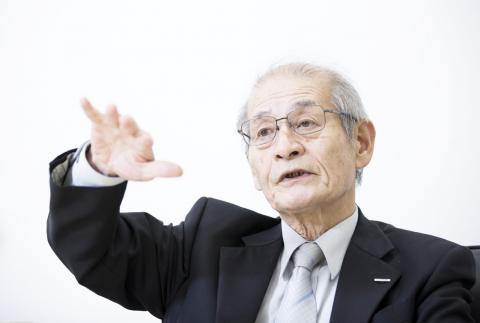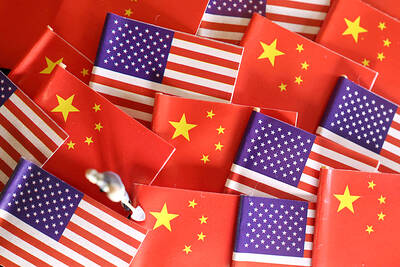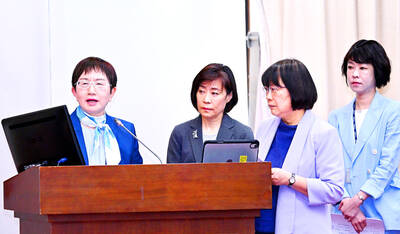Battery makers must rethink their technology if predictions for a wave of self-driving vehicles pan out, one of the inventors of the lithium-ion battery said.
Aside from focusing on making batteries more powerful to extend the driving range of single-owner cars, manufacturers will need to develop devices that can withstand the rigors of near-constant driving and short-range trips from the shared use expected of autonomous vehicles, said Akira Yoshino, who invented a prototype of the lithium-ion battery in 1985.
“A car shared by 10 people means it will be running 10 times more,” Yoshino, an honorary fellow at Asahi Kasei Corp., the world’s biggest maker of separators used in batteries, said in an interview at the company’s headquarters in Tokyo. “Durability will become very important.”

Photo: Bloomberg
While producers should still focus on improving energy density and lowering costs, they will also need to create batteries using materials that can better withstand constant expansion and contraction, Yoshino said.
The task becomes easier if there is less need to simultaneously boost energy density, which is the biggest factor for driving range, he said.
Lithium titanate, for example, can be used in the anode of the battery, where carbon is used commonly now.
“Cars are a completely new application, and we’ll have to wait until we find out what kind of batteries will really be needed,” Yoshino said. “The future of batteries depends on what will happen to the future of the automobile society.”
At Asahi Kasei’s laboratory in the early 1980s, Yoshino began researching polyacetylene, a conducting polymer discovered by the Japanese chemist and Nobel Prize winner Hideki Shirakawa. Although the material could be used in solar panels and semiconductors, Yoshino focused on batteries as a wave of small electronic devices requiring powerful, rechargeable energy sources began hitting the market.
He succeeded in building a lithium-ion battery using polyacetylene as the anode, later switching to carbon. However, Sony Corp beat Asahi Kasei in the race to commercialize it for mobile phones in 1991. The following year, Asahi Kasei formed a venture with Toshiba Corp to make and sell their own batteries.
“I thought it would be a boon to tap into the 8-millimeter video camera market,” Yoshino said, referring to an outdated format.
“Mobile phones, laptops and computers just kept multiplying, but no one was thinking about cars” at that time, he said.
That has since changed. Bloomberg New Energy Finance (BNEF) projects electric vehicles will account for 54 percent of new car sales by 2040. Highly autonomous cars are expected in about 2020, but technical and legal challenges to mass-market use of fully autonomous cars will not be solved before 2030, BNEF said in a Dec. 1 report.
Yoshino was a recipient with three others of the 2014 Charles Stark Draper Prize for engineering for their contribution to the development of the lithium-ion battery.

‘SWASTICAR’: Tesla CEO Elon Musk’s close association with Donald Trump has prompted opponents to brand him a ‘Nazi’ and resulted in a dramatic drop in sales Demonstrators descended on Tesla Inc dealerships across the US, and in Europe and Canada on Saturday to protest company chief Elon Musk, who has amassed extraordinary power as a top adviser to US President Donald Trump. Waving signs with messages such as “Musk is stealing our money” and “Reclaim our country,” the protests largely took place peacefully following fiery episodes of vandalism on Tesla vehicles, dealerships and other facilities in recent weeks that US officials have denounced as terrorism. Hundreds rallied on Saturday outside the Tesla dealership in Manhattan. Some blasted Musk, the world’s richest man, while others demanded the shuttering of his

Taiwan’s official purchasing managers’ index (PMI) last month rose 0.2 percentage points to 54.2, in a second consecutive month of expansion, thanks to front-loading demand intended to avoid potential US tariff hikes, the Chung-Hua Institution for Economic Research (CIER, 中華經濟研究院) said yesterday. While short-term demand appeared robust, uncertainties rose due to US President Donald Trump’s unpredictable trade policy, CIER president Lien Hsien-ming (連賢明) told a news conference in Taipei. Taiwan’s economy this year would be characterized by high-level fluctuations and the volatility would be wilder than most expect, Lien said Demand for electronics, particularly semiconductors, continues to benefit from US technology giants’ effort

ADVERSARIES: The new list includes 11 entities in China and one in Taiwan, which is a local branch of Chinese cloud computing firm Inspur Group The US added dozens of entities to a trade blacklist on Tuesday, the US Department of Commerce said, in part to disrupt Beijing’s artificial intelligence (AI) and advanced computing capabilities. The action affects 80 entities from countries including China, the United Arab Emirates and Iran, with the commerce department citing their “activities contrary to US national security and foreign policy.” Those added to the “entity list” are restricted from obtaining US items and technologies without government authorization. “We will not allow adversaries to exploit American technology to bolster their own militaries and threaten American lives,” US Secretary of Commerce Howard Lutnick said. The entities

Minister of Finance Chuang Tsui-yun (莊翠雲) yesterday told lawmakers that she “would not speculate,” but a “response plan” has been prepared in case Taiwan is targeted by US President Donald Trump’s reciprocal tariffs, which are to be announced on Wednesday next week. The Trump administration, including US Secretary of the Treasury Scott Bessent, has said that much of the proposed reciprocal tariffs would focus on the 15 countries that have the highest trade surpluses with the US. Bessent has referred to those countries as the “dirty 15,” but has not named them. Last year, Taiwan’s US$73.9 billion trade surplus with the US